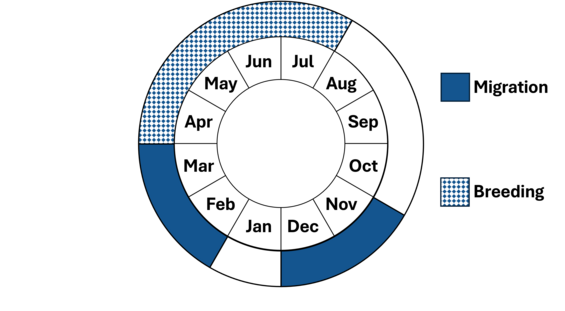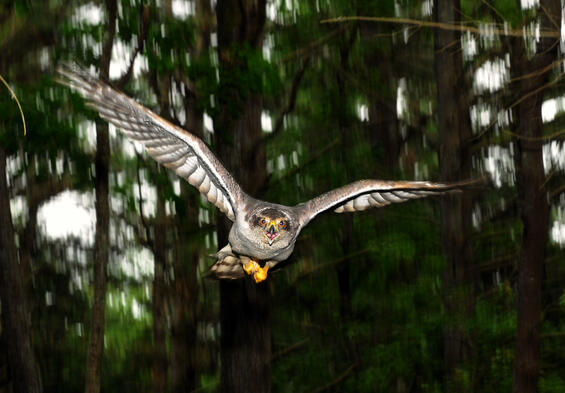- Scientific name: Astur atricapillus
- Species of Greatest Conservation Need (MA State Wildlife Action Plan)
Description
Northern goshwawk (Astur atricapillus)
Formerly known as the northern goshawk, the American goshawk is the largest accipiter species in the world and breeds in boreal and temperate forests throughout North America, including New England, New York, Pennsylvania, the Great Lakes states, the mountain west, Canada, and Alaska. As with other raptors, goshawks show size dimorphism, with females being approximately 30% larger than males. Adults of both sexes have a striking gray and white plumage, while juveniles have a brown plumage with a streaked breast. All birds have a bold, white supercilium. Goshawks are notorious for their aggressive behavior, and it is not uncommon for them to dive at people near their nest. This aggressive nature makes it a coveted species among falconers.
Life cycle and behavior

Goshawks generally breed in large forest tracts away from human disturbance and, in Massachusetts, are most common in highly forested areas of the central and western regions of the state. Adult goshawks typically remain on territory year-round. Goshawks can begin nesting in March and lay a clutch of 2-4 eggs. Incubation lasts for approximately 30 days and chicks make their first flights from the nest about 35 days after hatching. Adults continue to feed young after fledging, and the family unit remains intact for two months. The goshawk is a partial migrant where individuals may move south or to lower elevations during the winter months. Irruptive movements to the south generally occur in goshawk populations approximately every 10 years when populations of their primary prey (e.g., snowshoe hare, ruffed grouse) are low, but this hasn’t occurred for several decades.
Population status
In Massachusetts, American goshawks are an increasingly rare nester throughout much of the state and is generally absent through most of the southeast, including Cape Cod and the Islands. Although goshawks are not well represented in the Breeding Bird Survey, the Massachusetts Breeding Bird Atlas suggests that this species has undergone a large-scale decline throughout Massachusetts over the last several decades (Walsh and Petersen 2013). Reasons for this decline are speculative, but evidence throughout the Northeast is mounting that it may be the result of mortality of adults and young from West Nile Virus infection (introduced to New York in 1999 and quickly spread across the country) and nest predation from an increasing fisher (Pekania pennanti) population.
Distribution and abundance
The American goshawk breeding range includes forested habitat through much of Alaska and Canda, the mountain West, Great Lakes, and the Northeast. The distribution and abundance of goshawks in the northeastern states has fluctuated over time and was increasing until around 2000 but has since strongly declined (D. Brinker, Pers. Comm.). As a top predator, the breeding density of goshawks is naturally low, and they can be a difficult species to survey due to their large territories (average size of 600 ha.) and secretive nature.

Northern goshwawk (Astur atricapillus)
Habitat
American goshawks can be found nesting in a range of mature forest habitats including hardwood, mixed, or coniferous forests that occur at any elevation in the state. Territories are often established in large forest blocks, but goshawks have been known to nest within small, forested patches in a fragmented landscape. Nests are sometimes used for multiple years, but a pair often maintains 1-8 alternate nests within a nesting area. Forests with high canopy closure are preferred for nesting, and nests are typically placed just below the canopy in the largest tree in the forest stand. Nests may be placed near forest roads and small forest opening to serve as travel corridors and support open habitat prey, respectively.
Healthy habitats are vital for supporting native wildlife and plants. Explore habitats and learn about conservation and restoration in Massachusetts.
Threats
Threats to American goshawks include West Nile Virus and predation of nests and incubating adults by fishers. Timber harvesting can cause nest destruction by felling nesting trees and nest abandonment from nearby disturbance. Nest failures can be caused by disturbance around nests and legal/illegal taking of chicks for the falconry trade.
Rodenticides (e.g., Second Generation Anticoagulant Rodenticides - SGARs) move up food chains and pose a threat to raptors when they consume prey that have ingested these chemicals. As a result, SGARs have been found in a high percentage of raptors that have been tested for them in Massachusetts, and it is well documented that they can kill individual raptors. However, their population-level impacts on raptors remain largely unknown.
Conservation
Protection and management of large tracts of mature forest habitat is important for the conservation of this species. Limiting disturbance around known nest sites, especially during the breeding season, will promote nesting productivity. A standardized survey effort during the nesting period is needed to evaluate the current distribution of goshawks in the state and region to better focus conservation efforts.
Conduct research to better understand the impacts of highly toxic rodenticides (e.g., SGARs) to raptor populations. Promote an integrated pest management approach that emphasizes the use of alternative pest control measures whenever possible to reduce negative impacts to wildlife. Coordinate with other state agencies to improve tracking and reporting of rodenticides found in wildlife and develop outreach materials for the public.
References
Squires, J. R. and R. T. Reynolds (2024). American Goshawk (Astur atricapillus), version 1.2. In Birds of the World (N. D. Sly, Editor). Cornell Lab of Ornithology, Ithaca, NY, USA. https://doi.org/10.2173/bow.norgos.01.2
Sauer, J.R., J.E. Hines, J.E. Fallon, K.L. Pardieck, D.J. Ziolkowski, Jr., and W.A. Link. 2022. The North American Breeding Bird Survey, Results and Analysis 1966 – 2022. Laurel, MD.
Veit, R., and W.R. Petersen. 1993. Birds of Massachusetts. Massachusetts Audubon Society, Lincoln, Massachusetts.
Walsh, J. and W.R. Petersen. 2013. Massachusetts Breeding Bird Atlas 2. Massachusetts Audubon Society and Scott & Nix, Inc.
Contact
| Date published: | April 2, 2025 |
|---|